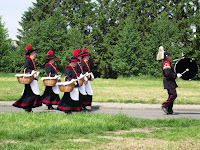On Saturday and Sunday, 2 & 3 June 2012 there will be a historical (Middle Ages) festival at Urmond, NL. Urmond is ten minutes away from Schinnen if traffic is light. Below is the schedule and my best translation.
Zaterdag 2 juni 2012 Saturday 2 June 2012
11.00-17.00 uur (gratis entree): Vrijmarkt/rommelmarkt, kunstmarkt in theetuin van de Protestantse kerk, tentoonstelling "Urmond Toen" in Protestantse kerk. From 11:00 to 5:00 (free Entry) is a Craft, art, and flea market in the Tea garden of the Protestant church. There is also an exhibition "Urmond Then" in the church.
19.00-23.00 uur (entree 2 euro): optreden De Maasbuben in Herberg De Vrijheid op Het Bath met om 20.00 uur het spectaculaire RIDDERTOERNOOI.From 7:00 to 11:00 PM (entry is €2) Best guess is this says a musical group called De Maasbuben will play at the festival tent called Herberg de Vrijhied on the street called "De Bath" on the Maas river side of town and then at 8:00 PM the spectacular Knights tournament.
Zondag 3 juni 2012 Sunday 3 June 2012
9.00 uur: Entree open (entreeprijs 5 euro inclusief gratis consumptie; kinderen tot 16 jaar gratis entree). Start doorlopende Middeleeuwse markt.9:00 (AM) Entrance is open (Entrance price is €5 which includes one free "consumptie" [food or drink chip or ticket]; children up to 16 are free) The Middle Ages market is open to walk through.
10.00 uur: zedenpreek door Middeleeuwse pastoor (Het Bath) 10:00 Sermon by a Middle Ages pastor at Het Bath)
10.30 uur: Middeleeuwse brunch in Herberg De Vrijheid op Het Bath. Deelname alleen mogelijk na inschrijving vooraf (inmiddels uitverkocht!). Muziek door Krebbel, troubadour Sjeng Fransse en minstrelen This Middle Ages brunch is already sold out so you can skip it
11.45 uur: optocht met bezoekers, fanfare, schutterijen, ridders, notabelen, Middeleeuws volk en personages vanaf Het Bath naar de Kooipoort 11:45 Parade with visitors, fanfare (marching band), shooting clubs (usually dressed in traditional garb), knights, notables, medieval people and characters from the Bath to the Kooi gateway (can't find it on a map but I guess there will be signs).
12.00 uur: opening Kooipoort door de schout (Burgemeester A. Barske) 12:00 Official opening by Major A. Barske.
12.15 uur: optreden muziekgroep Krebbel (podium kerk)12:15 performance by musical group "Krebbel"
12.30 uur: optreden drumband St. Martinus (Het Bath) 12:30 performance by drumband St. Matinus
12.45 uur: optreden muziekgroep Kapriol' met balfolk (podium kerk) 12:45 Performance by musical group Kapriol with folk dancers
13.30 uur: binnenkomst hertog van Gulick en HISTORISCH SPEL door Middeleeuws volk en personages (podium bij kerk) 1:30 Entrance of Duke van Gulick and a historical play with Medieval characters and persons (podium by the church)
13.30 uur: optreden 2 of a kind (Het Bath)1:30 performance by "2 of a Kind" at Het Bath
14.15 uur: optocht vanaf podium bij kerk naar riddertoernooi op Het Bath 2:15 Parade from the church podium to the knights tournament at Het Bath.
14.15 uur: optreden Krebbel (podium kerk) 2:15 performance by "Krebbel" at the church podium
14.30 uur: RIDDERTOERNOOI op Het Bath2:30 Knight's Tournament at Het Bath
14.50 uur: optreden Kapriol' met balfolk (podium kerk)2:50 Performance by Kapriol with folk dancers at the church podium
15.30 uur: 2e opvoering binnenkomst hertog en HISTORISCH SPEL bij podium kerk 3:30 second performance of the entrance of the Duke and a historical play by the church podium
15.45 uur: optreden 2 of a kind (Het Bath)3:45 performance of "2 of a Kind" at Het Bath
16.30 uur: 2e opvoering RIDDERTOERNOOI op Het Bath 16:30 second performance of the knights tournament at Het Bath
16.30 uur: optreden Krebbel (podium kerk)4:30 performance or Krebbel at the church podium
17.00 uur: optreden Kapriol' met balfolk (podium kerk) 5:00 performance of Kapriol with folk dancers at the church podium
17.15 uur: optreden 2 of a kind (Het Bath) 5:15 performance of "2 of a Kind" at Het Bath
19.00 uur: sluiting historisch festival met heksverbranding op Het Bath 7:00 closing of the historical festival with a wirch burning at Het Bath
9.00-19.00 uur: doorlopend Middeleeuwse markt met diverse kramen, historische groepen, personages en activiteiten, optredens van diverse muziekgroepen, kinderspelen, ponyrijden en springkussen op Het Bath, roofvogelshow, boogschutter, ganzenhoeder etc. 9:00 to 7:00 PM continuous medieval market with diverse stalls, historical groups, persons and activities, performances by diverse musical groups, children's games, pony rides, and bouncing house at Het Bath, birds of prey show, archery, goose herder, etc.
s' Middags lezingen en tentoonstelling "400 jaar Schippershuis" in het Schippershuis. All afternoon (both days I think) of lectures and exhibit of the "400 Years Shipper's House" at the Shipper's house.











